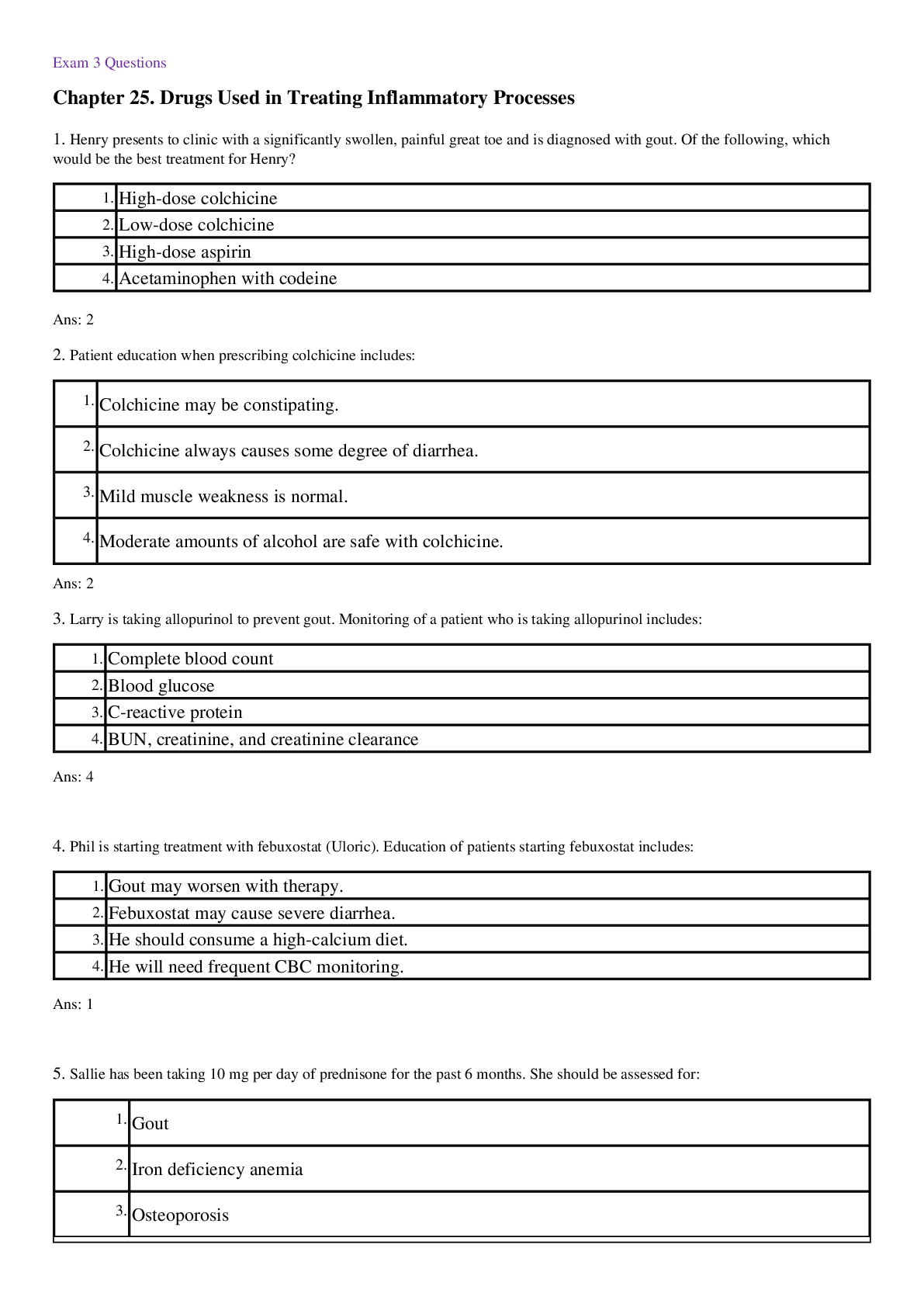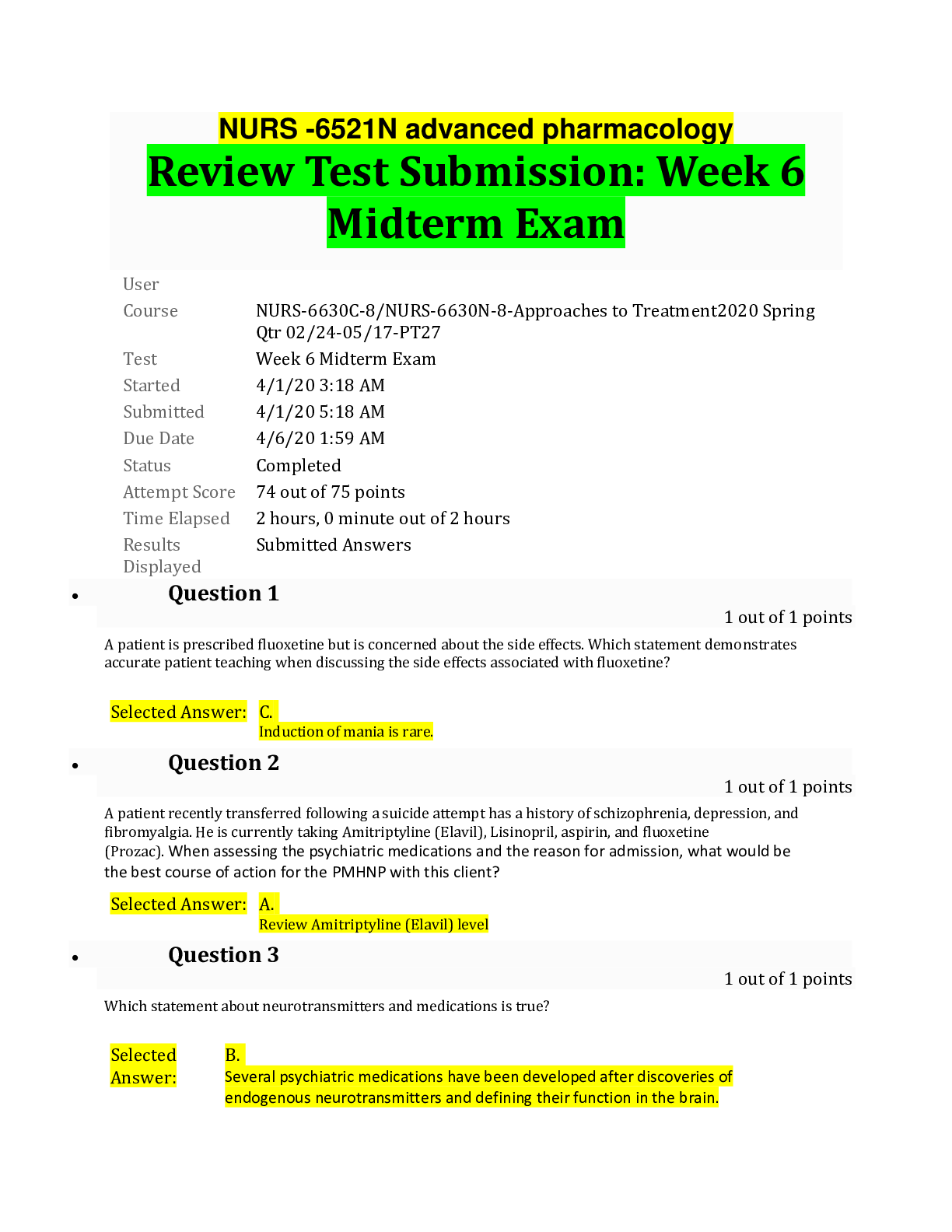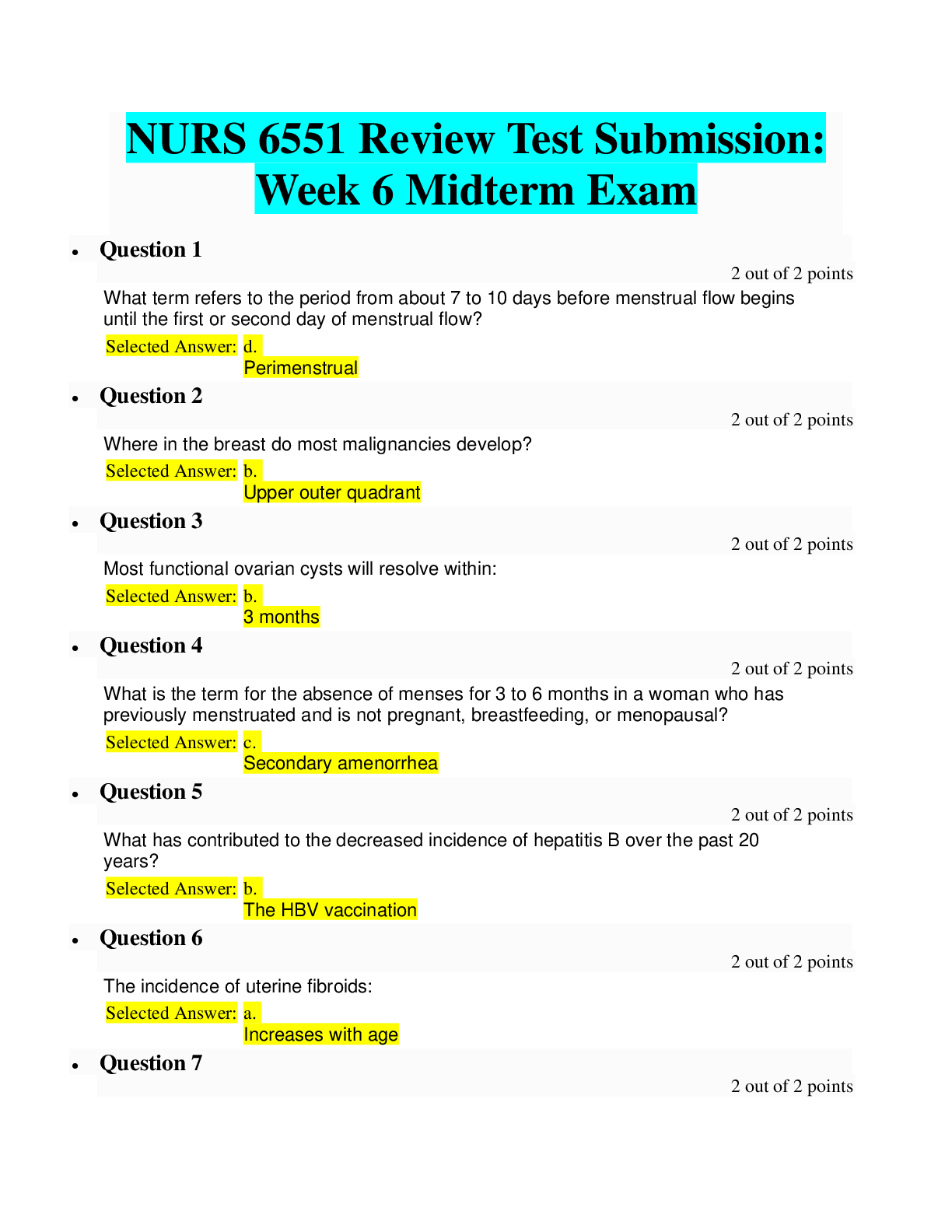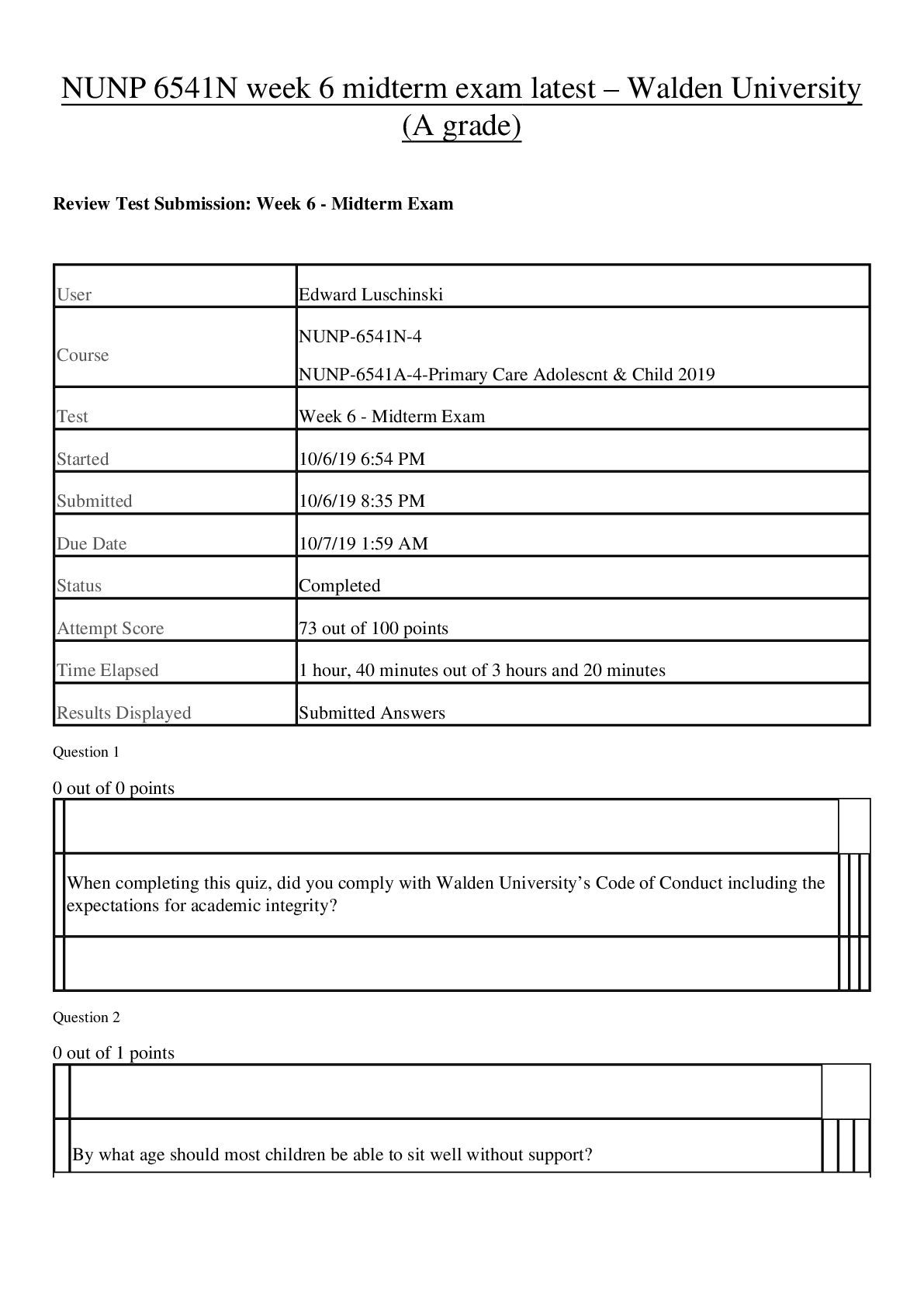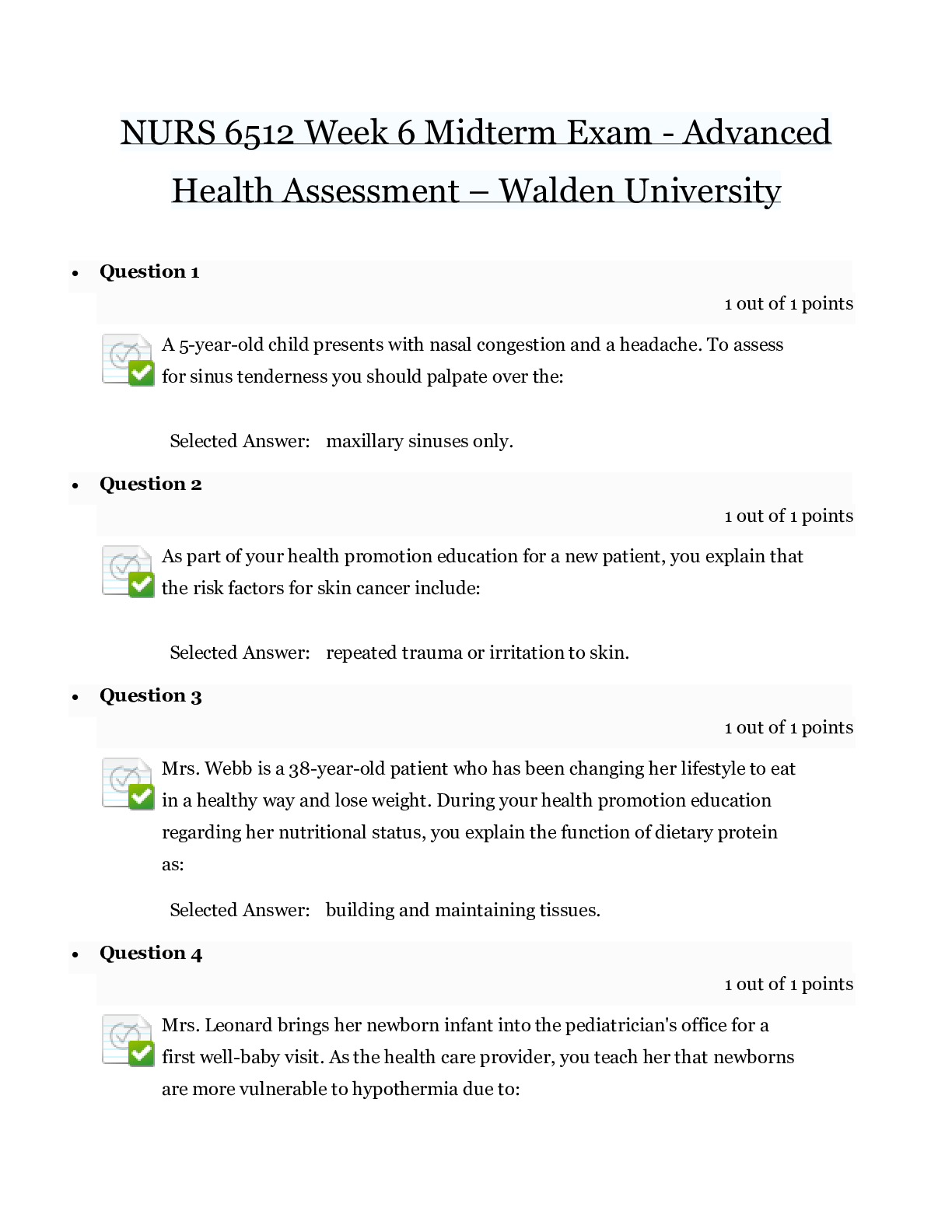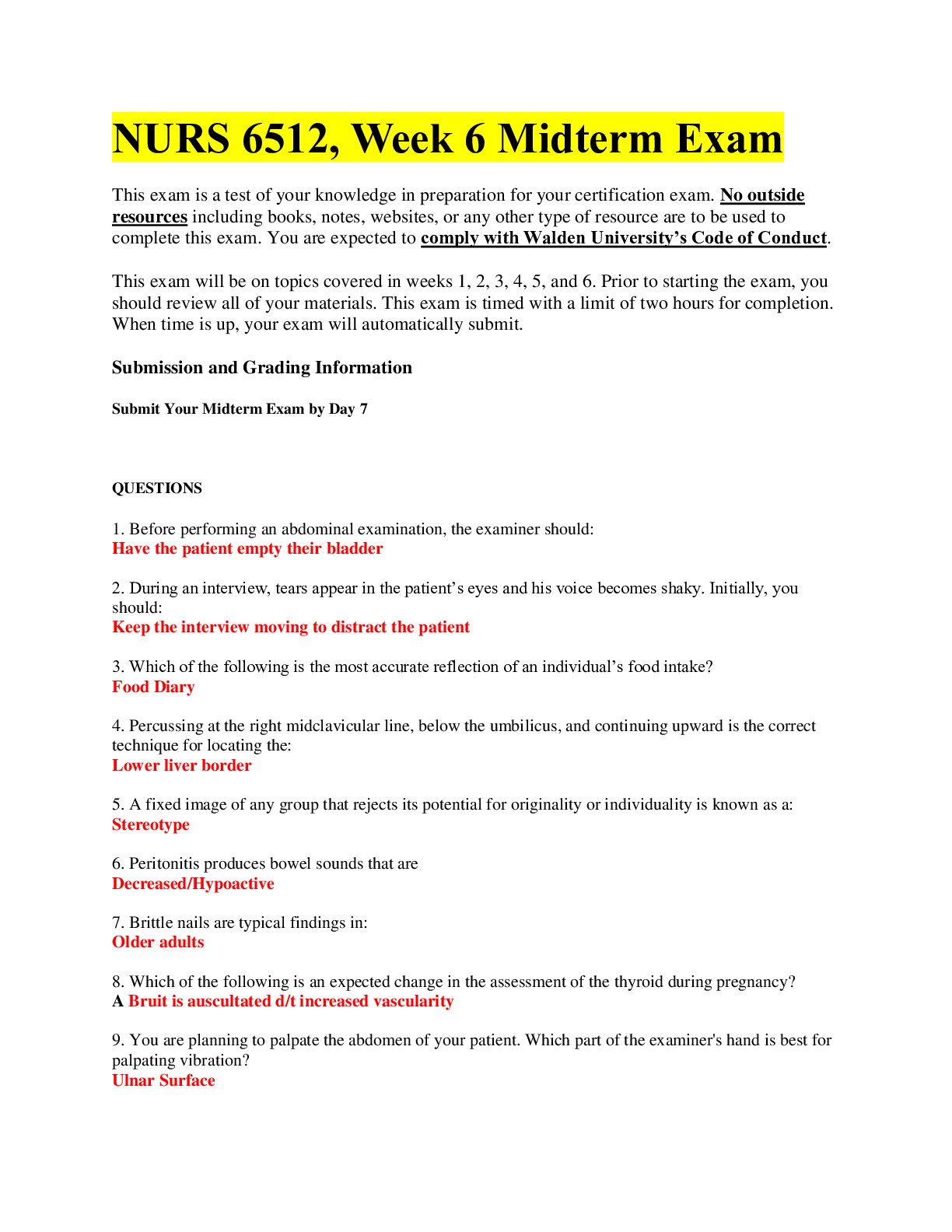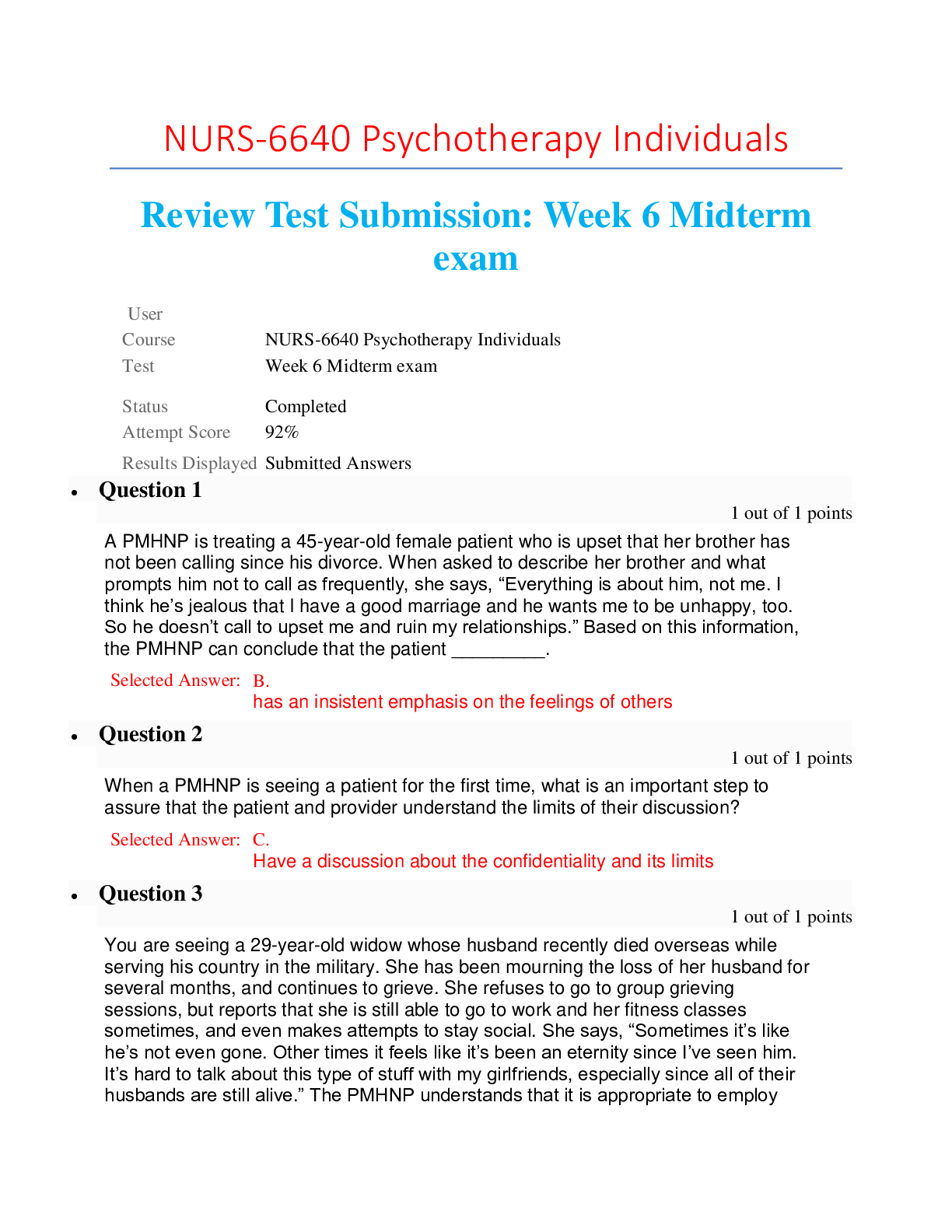NURS 6630 week 6 Midterm Exam Final
Document Content and Description Below
NURS 6630 week 6 Midterm Exam Final NURS 6630 week 6 Midterm Exam Final Test description DescriptionInstructions Timed Test This test has a time limit of 2 hours.You will be notified whentimeexpi... res, and you may continue or submit. Warnings appear when half the time, 5 minutes, 1minute, and 30 seconds remain. Multiple Attempts Force Completio n Not allowed. This test can only be taken once. Once started, this test must be completed in one sitting. Donot leavethe test before clicking Save and Submit. Remaining Time: 13 minutes, 04 seconds. Question Completion Status: A “You have to take your medication to become stable.” . B “ Medications work by increasing the types of neurotransmitters produced by the human brain.” . C “Most medications that work in the brain will result in restoring an imbalance of one or more . neurotransmitters that your body already produces helping to alleviate your symptoms .” D “Why do you believe that your medication is poison?” . 1 points QUESTION 1 1. A noncompliant patient states, “Why do you want me to put this poison in my body?” Identify the best response made by the psychiatric-mental health nurse practitioner (PMHNP).NURS 6630 week 6 Midterm Exam Final QUESTION 2 1. Ms. Hill is currently being treated for schizophrenia but has stopped taking her medications due to some side effects she claims she was experiencing.She presentsto the clinic today with worsening symptoms. She is experiencing anhedonia, agitation, attentional impairment, and affective blunting. Which one of the symptoms mentioned is considered a positive symptom of schizophrenia?NURS 6630 week 6 Midterm Exam Final A Anhedonia . B Agitation . C Attentional Impairment . D Affective Blunting . 1 points QUESTION 3 1. Which statement about neurotransmitters and medications is true? A Endorphins were discovered before morphine which lead to the use of the opioids for pain . control. B Several psychiatric medications have been developed after discoveries of endogenous . neurotransmitters and defining their function in the brain. C Medications work by sending messages to neurotransmitters enabling them to work more . effectively. D An imbalance of serotonin has been directly linked to depression. Following the discovery of this . neurotransmitter, pharmacologists were able to develop a well-known drug- Prozac as the first medication used to restore the balance of serotonin. 1 points QUESTION 4 1. When an unstable patient asks why it is necessary to add medications to his currentregimen,the PMHNP’s best response would be: A "More often than you would think, multiple medications should always be tried together to see . what happens.” B “Due to this being your first hospitalization after starting medication treatment for the first time . in your life, the only way to effectively manage your symptoms is by adding additionalmedications in hopes that it will work for you." C “Many psychiatric illnesses involve several dys-functioning neurotransmitter systems in the . brain. Often, a single medication may only effect one or two of the dys-functioning systems. Theaddition of another medication can work with the current medication in stabilizing multiple neurotransmitter systems and help to alleviate your symptoms.” D “I understand your concerns. Often times, it is necessary to switch medications after short . periods of time to better manage your symptoms. We will discontinue your current regimen andstartanother single drug agent.” 1 points QUESTION 5 1. During gene expression, what must occur prior to a gene being expressed? A Transcription factor must bind to the regulatory region within . the cell’s nucleus.NURS 6630 week 6 Midterm Exam Final B RNA must be converted to mRNA. . C The coding region must separate from the regulatory region. . D RNA polymerase must inhibit the process of changing RNA to . mRNA. 1 points QUESTION 6 1. While genes have potential to modify behavior, behavior can also modify genes. Howdo genesimpact this process? A Genes impact neuron functioning directly. . B Changes made to proteins lead to changes in . behavior. C Neurons are able to impact protein synthesis. . D Genes impact the DNA of a cell, leading to . changes in behavior. 1 points QUESTION 7 1. Though medications have the ability to target neurotransmitter release into the synapse by the presynaptic neuron it is not always necessary. The PMHNP understands that this isbecause: A Neurotransmission occurring along the axon is normally at a level to prevent symptoms of . mental illness and rarely require augmentation from medication therapy. B Neurotransmission is minimally affected by medication therapy when compared to the baseline . neurotransmitter release of a resting neuron. C Neurotransmitters can spread by diffusion. . D The post synaptic neuron can produce and release its’ own neurotransmitter allowing it to . function properly. 1 points QUESTION 8 1. Why is the cytochrome P450 enzyme system of significance to the PMHNP? A The kidneys play a role with excretion of the medication, and if a patient has kidney . damage, the dose must be increased to be effective. B The bioavailability of the medication after it passes through the stomach and liver . can be altered. C The medication’s chemical composition changes when it comes in contact with the . acid in the stomach.NURS 6630 week 6 Midterm Exam Final D The CYP enzyme system is a steady and predictable process that prescribers must . understand to treat conditions effectively. 1 points QUESTION 9 1. It is important for the PMHNP to recognize differences in pharmacokinetics to safely prescribe and monitor medications. Which of the following statements does the competentPMHNPidentify as true? A About 1 out of 5 Asians requires lower-than-normal doses of some antidepressants . and antipsychotics. B The term polymorphic refers to the body’s ability to break a medication down several . ways, and this patient may require higher doses of certain antidepressants andantipsychotics. C About 1 out of 30 Caucasians requires lower doses of some antidepressants and . antipsychotics. D Most enzyme pathways do not have interactions between the newer medications. . 1 points QUESTION 10 1. As it relates to G-protein linked receptors, what does the PMHNP understand aboutmedications that are used in practice? A Most medications that act on G-protein linked receptors have antagonistic traits. . B The majority of medications used in practice are full agonists and are used to . stimulate the body’s natural neurotransmitters. C Most medications act as partial agonists because they allow the body to use only . what is needed. D Medications used in practice may act as inverse agonists if the dosage is too high. . 1 points QUESTION 11 1. The PMHNP is considering prescribing a 49-year-old male clozapine (Clozaril) to treat his schizophrenia and suicidal ideations. The PMHNP is aware that which factor may impactthe doseneeded to effectively treat his condition: A The patient smokes cigarettes. . B The patient has hypertension. . C The patient has chronic kidney . disease, stage 2. D The patient drinks a cup of coffee aNURS 6630 week 6 Midterm Exam Final . day. 1 points QUESTION 12 1. A patient is diagnosed with bipolar disorder and is currently taking carbamazepine (Tegretol),aripiprazole (Abilify), and melatonin. The PMHNP has just written an order to discontinue the carbamazepine (Tegretol) for drug-induced thrombocytopenia. The PMHNP is aware that his next best action is to: A Alert staff to possible seizures . B Write an order for a different mood stabilizer . C Decrease the amount prescribed for aripiprazole . (Abilify) D Explain to the patient that it will be more difficult to . control his temper 1 points QUESTION 13 1. A patient recently transferred following a suicide attempt has a history of schizophrenia,depression, and fibromyalgia. He is currently taking Amitriptyline (Elavil),Lisinopril, aspirin, and fluoxetine (Prozac). When assessing the psychiatric medications and the reason for admission, what would be the best course of action for the PMHNP with this client? A Review Amitriptyline (Elavil) level . B Order a STAT BUN/SCr . C Asses the client for nystagmus . D Order a STAT platelet, D-dimer, and PT/INR . 1 points QUESTION 14 1. A patient with schizophrenia is given an inverse agonist that acts on the receptor 5HT and neurotransmitter serotonin. What is the rationale for prescribing a medication such asthis? A To promote the availability of serotonin . B To decrease serotonin . C To indirectly increase the amount of dopamine . in the body D To help decrease the amount of serotonin andNURS 6630 week 6 Midterm Exam Final . dopamine 1 points QUESTION 15 1. The PMHNP is caring for four patients. Which patient statement indicates thatbenzodiazepines would be beneficial? A “I have trouble staying asleep in the middle of the night.” . B “My spouse told me that I seem to have trouble remembering . things sometimes.” C “I really want to stop smoking, but the cravings are too strong.” . D “I feel nervous to go outside and be in large crowds.” . 1 points QUESTION 16 1. Ms. Harlow is a 42-year-old patient who is prescribed a drug that acts on ionotropic receptors.She is curious about the effects of the drug and how it will act on her symptoms. Which statement made by the PMHNP demonstrates proper understanding of Ms. Harlow’s prescription? A “The drug will have an almost immediate . effect.” B “The drug can take a while to build up in your . system.” C “The drug is slow to release but lasts for a long . time.” D “The drug will make a subtle difference in your . symptoms.” 1 points QUESTION 17 1. A patient is seeking pharmacological treatment for smoking cessation. Which drugclassdoes the PMHNP prescribe to the patient? A Benzodiazepine . B Mirtazapine . (Remeron) C Ketamine . D Varenicline . (Chantix)NURS 6630 week 6 Midterm Exam Final 1 points QUESTION 18 1. The PMHNP is caring for a new patient who has been transferred from another office. When meeting with the new patient, the patient reports, “I feel like I am improving with thestabilizers.” ThePMHNP immediately recognizes that the patient is describing which kind of drug? A Full agonists . B Antagonists . C Partial . agonists D Inverse . agonists 1 points QUESTION 19 1. A patient presents with frequent episodes of mania. Which statement describes anappropriate treatment approach for this patient? A “The patient needs to have an inverse agonist.” . B “The patient could benefit from an anticonvulsant.” . C “The patient’s calcium, sodium, chloride, and potassium levels . must be regulated.” D “The patient should have a drug that acts on ligand-gated ion . channels.” 1 points QUESTION 20 1. What characteristics do the nicotinic, cholinergic, serotonin 3, and glycine receptors all have incommon? A Ligand-gated ion channels with a . pentameric structure B Ligand-gated ion channels with a . tetrameric structure C Voltage-sensitive ion channels . D Are G-coupled protein receptors . 1 points QUESTION 21NURS 6630 week 6 Midterm Exam Final A “It’s my fault that all of this is happening. I don’t think I could ever . forgive myself.” B “I have to talk to the President because I’m the only one who can . help him.” C “I’m not sure why that lady is wearing a red jacket since it’s the dogs . who need food.” D “I don’t know that I even want to go to that meeting. It doesn’t seem . worth it anymore.” 1 points QUESTION 22 1. Mr. McCullin is 64 years old with Parkinson’s disease. The PMHNP caring for Mr. McCullinwants to start him on a dopamine agonist to help manage and treat his condition. The PHMNP selects this agent because of which action it has on patients like Mr. McCullin? A Dopamine is terminated through multiple mechanisms. . B The D2 autoreceptor regulates release of dopamine from the . presynaptic neuron. C MAO-B presents in the mitochondria within the presynaptic . neuron. D D2 receptors are the primary binding site for dopamine . agonists. 1 points QUESTION 23 1. Mrs. Trevor is a 44-year-old patient who does not have a diagnosis of schizophreniabutoccasionally reports symptoms of psychosis, followed by severe fatigue. Mrs. Trevor inquires about the use of amphetamines to help with her energy levels. Which responsemade by thePMHNP is most appropriate? A “Amphetamines may help you, as they can alleviate psychotic conditions.” . B “Amphetamines can inhibit negative symptoms of schizophrenia, so this might be a . good choice for you.” C “Amphetamines can cause hallucinations, so I would advise against this type of . prescription.” D “Amphetamines can lead to a dopamine deficiency, so I will not prescribe this for . you.” 1 points QUESTION 24 1. Which statement made by the patient suggests the patient will need to be treated with antipsychotics that target paranoid psychosis?NURS 6630 week 6 Midterm Exam Final A Blocking the release of dopamine facilitates the onset of positive schizophrenia . symptoms. B Hyperactivity in the mesolimbic dopamine pathway mediates the positive . symptoms of schizophrenia. C Antipsychotic drugs that open D2 receptor pathways can treat schizophrenia. . D The neuroanatomy of dopamine neuronal pathways can explain symptoms of . schizophrenia. 1 points QUESTION 25 1. A patient is diagnosed with schizophrenia. What increases the patient’s potential tomediatethe cognitive symptoms of the disease? A Achieving underactivity of the mesocorticol projections to the prefrontal . cortex B Achieving overactivity of the mesocorticol projections to the ventromedial . prefrontal cortex C Achieving underactivity of the mesocortical projections to the . ventromedial prefrontal cortex D Achieving overactivity of the mesocorticol projections to the prefrontal . cortex 1 points QUESTION 26 1. What is accurate about the clinical description of psychosis? A It is simply a separate way to clinically describe the diagnosis of schizophrenia in . a client. B Psychosis is listed in the DSM as a distinct disorder with unique screening criteria. . C It is a syndrome that can be associated with a number of psychiatric disorders. . D Psychosis is always demonstrated by a paranoia in the client. . 1 points QUESTION 27 1. The PMNHP is assessing a 29-year-old client who takes antipsychotics that block D2 receptors. This client has begun to develop a common side effect of thismedication.What is this side effect? 1. The PMHNP is caring for a patient with schizophrenia and is considering a variety of treatment approaches. The PHMNP selects a viable treatment that is consistent with the “dopamine hypothesis of schizophrenia.” What action does the PMHNP anticipate this treatment having on the patient?NURS 6630 week 6 Midterm Exam Final A Increased hallucinations and positive symptoms . B Hypersexuality . C Reduction in negative symptoms . D Tardive dyskinesia . 1 points QUESTION 28 1. The PMHNP is caring for a patient who is taking antipsychotics heard the psychiatrist tell thepatient that the patient would be placed on a different antipsychotic agent called an atypical antipsychotic. What neurotransmitters will this new medication work on? A dopamine and serotonin . B dopamine and norepinephrine . C dopamine and GABA . D GABA and glutamate . 1 points QUESTION 29 1. Which statement made by the PMHNP exemplifies correct teaching of physiologicaleffectsin the body? A Muscarinic antagonists are more likely to cause decreased prolactin levels. . B D2 antagonists decrease the likelihood of EPS symptoms. . C D2 antagonism is linked to antidepressant properties. . D D2 partial agonists are associated with increased efficacy in treating positive . symptoms of schizophrenia. 1 points QUESTION 30 1. Mrs. Schwartzman is a 52-year-old patient with schizophrenia and no established history of depression. When meeting with the PMHNP, she presents with apathy and withdrawn social behavior, and she reports a loss of joy from enjoyable activities. What does the PMHNP infer from this encounter with the patient? A An underlying depressive disorder .NURS 6630 week 6 Midterm Exam Final B The recent change of a 2nd generation antipsychotic to a . conventional one C The recent change of a 1st generation antipsychotic to a 2nd . generation antipsychotic D All of the above . 1 points QUESTION 31 1. Mrs. Schwartzman is a 52-year-old client with schizophrenia and no established history of depression.When meeting with the PMHNP, she presents with apathy and withdrawn social behavior, and she reports a loss of joy from enjoyable activities since starting her new medication. What does thePMHNPinfer from this encounter with the client? A The client has been misdiagnosed with schizophrenia . B The client is not compliant with this new medication . C The new medication is blocking D2 receptors in the mesolimbic . system D The dose of this new antipsychotic medication is too low . 1 points QUESTION 32 1. The student inquires about antipsychotic medications. Which response by the PMHNP describes the factors that contribute to reduced risk of extrapyramidal symptoms (EPS) forpatients who take antipsychotics? A Those that are potent D2 antagonists . B Those that are potent D2 antagonists with 5HT2A antagonism . properties C D2 receptors that are blocked in the nigrostriatal pathway . D Potent D2 antagonists that block the muscarinic anti-M1 . cholinergic receptors 1 points QUESTION 33 1. Mr. Gordon is a middle-aged patient who is taking antipsychotics. When meeting withthe PMHNP, he reports positive responses to the medication, stating, “I really feel as though the effects of my depression are going away.” Which receptor action in antipsychotic medications is believed tobe the most beneficial in producing the effects described by Mr. Gordon? A 5HT2 . antagonismNURS 6630 week 6 Midterm Exam Final B D2 antagonism . C Alpha-2 . antagonism D D2 partial . agonist 1 points QUESTION 34 1. Mr. Gordon is a middle-aged client who was started on antidepressant monotherapy for depression. After beginning this medication, the PMHNP noticed that this client seemed to swing into ahypomanic episode. What can the PMHNP infer from this behavior change? A This client may have Bipolar III disorder . B The antidepressant monotherapy should be . continued C A second antidepressant agent should be added as dual therapy . D A and C . 1 points QUESTION 35 1. Ms. Ryerson is a 28-year-old patient with a mood disorder. She recently requested to transfer to a new PMHNP, after not getting along well with her previous provider. The new PHMNP is reviewing Ms. Ryerson’s medical chart prior to their first appointment. Upon review, the PMHNP seesthat the former provider last documented “patient had rapid poopout.” What does the PMHNP infer about the patient’s prescription based on this documentation? A The patient has an unsustained response to . antidepressants. B The patient has antidepressant-induced . hypomania. C The patient has a depletion of monoamine . neurotransmitters. D The patient has an adverse effect to atypical . antipsychotics. 1 points QUESTION 36 1. The PMHNP recognizes that which patient would be contraindicated forantidepressant monotherapy? A Patient with a bipolar I . designationNURS 6630 week 6 Midterm Exam Final B Patient with a bipolar II . designation C Patient with a bipolar III . designation D None of the above . 1 points QUESTION 37 1. The PMHNP spends a session with a client and notices behaviors correlating with apotential manic episode. All of the following are possible manic symptoms thePMHNP could observe except: A Pressured speech . B Less time sleeping . C Irritable mood . D A low self esteem . 1 points QUESTION 38 1. The PMHNP is caring for a patient with the s genotype of SERT. What does the PMHNP understand regarding this patient’s response to selective serotonin reuptake inhibitor(SSRI)/SNRItreatment? A The patient has a higher chance of tolerating SSRI/SNRI . treatment. B The patient will have a positive response to SSRI/SNRI . treatment. C The patient will develop severe mood cycling in . response to treatment. D The patient may be less responsive or tolerant to the . treatment. 1 points QUESTION 39 1. Ms. Boeckh is a 42-year-old patient with major depression. The PMHNP understandsthatwhich action of norepinephrine will affect Ms. Boeckh’s serotonin levels? A Norepinephrine potentiates 5HT release through a2 . postsynaptic receptors. B Norepinephrine inhibits 5HT release through a2 receptors. .NURS 6630 week 6 Midterm Exam Final C Norepinephrine inhibits α2 receptors on axon terminals. . D Norepinephrine potentiates 5HT release through a1 and a2 . receptors. 1 points QUESTION 40 1. Ms. Boeckh is a 42-year-old client who is taking an antidepressant therapy. The PMHNP understandsthat this medication can have substantial food interactions that can cause Ms. Boeckh todevelop a hypertensive crisis. Which antidepressant class is Ms. Boeckh’s medication in? A Selective serotonin reuptake inhibitors . B MAO inhibitors . C Tricyclic antidepressants . D Selective norepinephrine reuptake inhibitors . 1 points QUESTION 41 1. The PMHNP is assessing a patient in the psychiatric emergency room. The patient tells the PMHNP that he does not understand why his depression has not lifted after being on four different antidepressants over the course of a year. Which of the following symptoms can be residual symptoms for patients who do not achieve remission with major depressive disorder? A Insomnia . B Suicidal ideation . C Problems . concentrating D A and C . 1 points QUESTION 42 1. Fluoxetine (Prozac) has been prescribed for a patient. Which of the followingstatements is true regarding the action of this medication? A Neuronal firing rates are not dysregulated in depression. . B Blocking the presynaptic SERT will immediately lead to a great deal of serotonin in . many synapses. C Upon the acute administration of a SSRI, 5HT decreases. .NURS 6630 week 6 Midterm Exam Final D The action at the somatodendritic end of the serotonin neuron may best explain the . therapeutic action of SSRIs. 1 points QUESTION 43 1. Fluoxetine (Prozac) has been prescribed for a client with depression. Which ofthe following statements is true regarding the action of this medication? A Fluoxetine causes an immediate resolution of the client’s depression. . B Fluoxetine inhibits the serotonin transporter (SERT). . C Upon the acute administration of fluoxetine, serotonin levels decrease. . D Fluoxetine has a significant binding affinity to cholinergic receptors. . 1 points QUESTION 44 1. The nurse education knows that teaching was effective when one of the students comparesfluvoxamine to sertraline and notes which of the following similarities? A Both have a sedative-like, calming effect. . B Both inhibit the dopamine transporter which increases the levels of dopamine. . C Both agents are approved for the treatment of depression in the United States . D Both have actions at sigma receptors which contribute to both anxiolytic and antipsychotic effects. . 1 points QUESTION 45 1. A 45 year old female client with allergic rhinitis and normal blood pressure has had no reduction in depressive symptoms after trying bupropion, paroxetine, and venlafaxine. Whatprecautions are needed when considering phenelzine in treating herdepression? A The client should be counseled to avoid all antihistamines for allergic rhinitis while taking an . MAOI B The client will need to minimize dietary intake of foods that are high in tyramine. . C The client must avoid dental work that require an anesthetic while on an MAOI. . D All non-opioids and opioid analgesics must be avoided when taking an MAOI. . 1 pointsNURS 6630 week 6 Midterm Exam Final A First onset in puberty or early . adulthood B Late onset of menses . C Premenstrual syndrome . D A and C . 1 points QUESTION 47 1. A nurse overhears that a patient has failed single therapy with an SSRI and SNRI. Shealso learns that the patient has been on dual SSRI/SNRI therapy without adequate symptom control. She approaches the PMHNP and asks what the next treatment option could be in this seemingly treatment-resistant patient. The PMHNP tells the nurse she willtreat the patient with the following regimen: A MAOI plus SNRI . B SSRI/SNRI plus NDRI . C NDRI/SNRI plus . mirtazapine D NDRI plus modafinil . 1 points QUESTION 48 1. A nurse overhears that a client has failed monotherapy with an SSRI and an SNRI. Shealso learns that the client has failed dual SSRI + SNRI therapy. The nurse approaches the PMHNP and asks what treatment options should be considered in thistreatment resistant client. The PMHNP tells the nurse that she will treat the client with the following regimen. A SSRI + SNRI . B SSRI + NDRI . C SSRI + MAOI . D SSRI + Mood stabilizer . QUESTION 46 1. A 51-year-old female patient presents with symptoms of depression, including lack of motivation and difficulty sleeping. What risk factors would increase her vulnerability for a diagnosis of depression?NURS 6630 week 6 Midterm Exam Final 1 points QUESTION 49 1. A patient is prescribed fluoxetine but is concerned about the side effects. Which statement demonstrates accurate patient teaching when discussing the side effectsassociated with fluoxetine? A Weight gain can be . problematic. B Sedation is very . common. C Induction of mania is . rare. D Seizures are not unusual. . 1 points QUESTION 50 1. A client is prescribed fluoxetine but is concerned about side effects. Which statement demonstrates accurate client teaching when discussing the side effects associated with fluoxetine? A Weight gain is common . B Sedation is common . C Sedation is unusual . D Seizures occur frequently . 1 points QUESTION 51 1. A 25-year-old female patient is being prescribed milnacipran to treat fibromyalgia,andexpresses concern regarding “how she will feel and look” from taking the medicine. Which statement correctly describes the side effects as a result of taking this medication? A It can affect her menstruation. . B Suicidality can be common among . young adults. C Sedation may be problematic. . D Weight gain is unusual. . 1 points QUESTION 52NURS 6630 week 6 Midterm Exam Final A He has . fibromyalgia. B He has . arrhythmia. C He uses alcohol. . D He is . overweight. 1 points QUESTION 53 1. A patient is prescribed sertraline to treat panic disorder. Knowing that sertraline caninitiallycause anxiety or insomnia, what should the PMHNP do? A Prescribe long-acting benzodiazepine for 2 weeks, then . increase the dose. B Prescribe short-acting benzodiazepine for 2 weeks, then . discontinue. C Prescribe long-acting benzodiazepine for 2 weeks, then . discontinue. D Prescribe short-acting benzodiazepine for 2 weeks, then . increase the dose. 1 points QUESTION 54 1. A patient is prescribed 50 mg of desvenlafaxine to take every other day for majordepressive disorder. What does the PMHNP understand about this patient? A The patient has hepatic . impairment. B The patient has moderate renal . impairment. C The patient has severe renal . impairment. D The patient has cardiac . impairment. 1 points QUESTION 55 1. Mr. Ruby is a 33-year-old single father who is requesting pharmacological intervention to treat his fibromyalgia. The PMHNP sees in the medical chart that he has a recent diagnosis of arrhythmia and a BMI of 29. During his assessment, the PMHNP learns that Mr. Ruby works 40–50 hours a week as a contractor and “manages his stress” by smoking 3–4 cigarettes a day and having 8–10 drinks of alcohol each week. Why would duloxetine be contraindicated for Mr. Ruby?NURS 6630 week 6 Midterm Exam Final A Histamine H1 receptor blockade can cause . insomnia. B Muscarinic M1 receptor blockade causes . blurred vision. C Alpha 1 adrenergic receptor blockade causes . weight gain. D Muscarinic M3 receptor blockade causes . sedation. 1 points QUESTION 56 1. A patient who was prescribed an MAO inhibitor is learning about dietary modifications. Whichstatement made by the PMHNP demonstrates proper teaching of the food-drug interactions for MAO inhibitors? A “You must avoid soy products, such as . tofu.” B “You should not consume processed . meats.” C “You may consume fermented foods, like . sauerkraut.” D “You may continue to drink beers on tap.” . 1 points QUESTION 57 1. A patient who is prescribed MAO inhibitors asks about whether he can continue takingpseudoephedrine to relieve his congestion. Which response by the PMHNP indicates proper understanding of drug-drug interactions? A “Decongestants are fine to continue taking with MAO . inhibitors.” B “Decongestants are okay to take with MAO inhibitors in . moderation.” C “Decongestants should be avoided due to risk of . serotonin syndrome.” D “Decongestants should be avoided due to risk of . hypertensive crisis.” 1 points QUESTION 58 1. The PMHNP understands that which mechanism contributes to a worse tolerability profile for patients taking tricyclic antidepressants (TCAs)?NURS 6630 week 6 Midterm Exam Final A Ms. Skidmore is taking the correct dose of phenelzine (Nardil). . B Ms. Skidmore is not taking enough of the phenelzine (Nardil); she should be taking . three times that amount. C Ms. Skidmore is taking too much of the phenelzine (Nardil); she should be taking the . 45 mg in three doses. D Ms. Skidmore is taking too much of the phenelzine (Nardil); she is supposed to take . 45 mg every 24 hours. 1 points QUESTION 59 1. The PMHNP is caring for several patients who present with various symptoms andhealthissues. For which patient does the PMHNP prescribe pregabalin (Lyrica)? A Patient with PTSD . B Patient with partial seizures . C Patient with galactose . intolerance D Patient with Lapp lactase . deficiency 1 points QUESTION 60 1. Mr. Gutier is 72 years old with anxiety and depressive symptoms. His PMHNP is prescribing lorazepam (Ativan). What does the PMHNP understand regarding this prescription? A The PMHNP will prescribe less than 2-6 mg for Mr. Gutier to take . daily. B The PMHNP will require Mr. Gutier to take 2-4 doses of lorazepam . (Ativan) per day. C The PMHNP will prescribe more than 2-6 mg for Mr. Gutier to take . daily. D The PMHNP will have Mr. Gutier take 6 mg of lorazepam (Ativan) as . a PRN. 1 points QUESTION 61 1. Ms. Skidmore presents for a follow-up appointment after being prescribed phenelzine (Nardil), and reports “I take my 45 mg pill, three times a day, just like I’m supposed to.” What does the PMHNP understand about this patient?NURS 6630 week 6 Midterm Exam Final A mirtazapine . (Remeron) B doxepin (Silenor) . C alprazolam . (Xanax) D trazadone . (Oleptro) 1 points QUESTION 62 1. A patient who was diagnosed with bipolar disorder without mania, asks the PMHNPwhy heis being prescribed a mood stabilizer. What is the appropriate response? A Mood stabilizers are only prescribed to treat manic phases of bipolar depression . B Mood stabilizers can consistently treat both mania and bipolar depression . C Mood stabilizers can target mania and mania relapse and also reduce symptoms of . bipolar depression and relapse of bipolar depression symptoms but no drug has beenproven totarget all four therapeutic actions D Certain mood stabilizers, such as lithium, are able to consistently target mania and . bipolar depression 1 points QUESTION 63 1. A client who was diagnosed with bipolar disorder without mania, asksthePMHNP why he is being prescribed a mood stabilizer. What is the appropriate response? A Mood stabilizers only treat manic phases of bipolar disorder. . B Mood stabilizers only treat the depressive phases of bipolar disorder. . C Mood stabilizers can treat either manic phases or depressive phases of bipolar disorder. . D Mood stabilizer monotherapy is effective in treating bipolar disorder without mania. . 1 points QUESTION 64 1. A patient is being prescribed a sedating antidepressant, but is concerned about weight gain. Which medication is most likely to be prescribed to addresses the patient’s concerns?NURS 6630 week 6 Midterm Exam Final A Thyroid Stimulating Hormone . B Erythrocyte Sedimentation Rate . C Platelet Count . D Phosphate . 1 points QUESTION 65 1. A nursing student is seeking clarification on the use of anticonvulsants to treat depressionand is unclear about most effective outcomes. Which of the following agents does the PMHNP convey as having uncertain outcomes? A Carbamazepine . (Tegretol) B Gabapentin . (Neurontin) C Valporoic Acid . (Depakene) D All of the above . 1 points QUESTION 66 1. A nursing student is seeking clarification on the use of anticonvulsants to treat bipolardepression and is unclear about which anticonvulsants have the most effectiveoutcomes in treating bipolar depression. Which of the following anticonvulsants is NOTused for treating bipolar depression? A Carbamazepine (Tegretol) . B Gabapentin (Neurontin) . C Lamotrigine (Lamictal) . D Valproic Acid (Depakene) . 1 points QUESTION 67 1. The PMHNP is meeting with a new mother who would like to begin taking medicationagain totreat her bipolar depression; she is breastfeeding her 2-month old daughter. The 1. The PMHNP is assessing a client in the emergency room. The client shares thathe has been on lithium for many years. What blood test does the PMHNP order?NURS 6630 week 6 Midterm Exam Final A Valporic Acid . (Depakene) B Carbamazepine . (Tegretol) C Lithium (Lithobid) . D Lamotrigine . (Lamictal) 1 points QUESTION 68 1. The PMHNP is meeting with a new mother who would like to begin taking medication again to treat her bipolar depression; she is breastfeeding her 2-month olddaughter. The PMHNP recognizes that which of the following medications is contraindicated for this client? A Valproic Acid (Depakene) . B Carbamazepine (Tegretol) . C Lithium (Lithobid) . D Lamotrigine (Lamictal) . 1 points QUESTION 69 1. A patient was diagnosed with GAD 4 weeks ago and was placed on Clonazepam (klonopin)twice a day and citalopram (citalopram (celexa)) once daily. When he asks the PMHNP why it is necessary to wean him off of the Clonazepam (klonopin) the best response is: A Clonazepam (klonopin) may interfere with citalopram (celexa)s targeted areas in the . brain B Clonazepam (klonopin) is not recommended for long term use due to possible . sedation C Clonazepam (klonopin) was used as an aid to treat your condition while you were . adjusting to citalopram (celexa) D Clonazepam (klonopin) and citalopram (celexa) target the same area in the brain and . after long-term use they will begin to compete making one more or less effectivethan theother 1 points QUESTION 70 PMHNP recognizes that which of the following medications is contraindicated for this patient?NURS 6630 week 6 Midterm Exam Final A “Some medications can cause heart issues so it is necessary to rule those out before . you begin medication.” B “This is a part of our routine admission and it is important that you give me truthful . answers.” C “Chronic conditions such as Lupus can cause an area in your brain to malfunction, . specifically your hippocampus.” D “Anxiety can cause cortisol levels to increase and when this happens frequently it . puts you at risk for comorbidities such as type 2 diabetes.” 1 points QUESTION 71 1. There are a number of endocrine reactions that accompany fear. A quick boost of cortisol may enhancesurvival when encountering a real but short-term threat. However, chronic elevations in cortisolcan lead to increased medical comorbidities. Which of the following medical conditions may be related to these persistent cortisol elevations? A Increased rates of coronary artery disease . B Increased rates of type 2 diabetes . C Increased rates of stroke . D All of the above . 1 points QUESTION 72 1. The PMHNP understands that the potential of alcohol abuse in the anxious client is higher for the following reasons: a Alcohol exerts an effect on GABAA receptors. . b Alcohol increases serotonin levels . c Alcohol exerts an effect on the cannabinoid receptors . d Alcohol has an immediate action by altering G Protein Coupled Receptors . 1 points QUESTION 73 1. After ordering flumazenil (Rumazicon) the PMHNP cautions the staff to monitorfor which possible effect? A Agitation . 1. During assessment a patient states “Why are you asking me about my heart, I am here for my head”, the PMHNP’s best response is:NURS 6630 week 6 Midterm Exam Final B Seizures . C Sweating and Nausea . D All of the above . 1 points QUESTION 74 1. The PMHNP evaluates the patient for “fear conditioning” when he asks: A Have you ever experienced any type of trauma? . B What do you do when you feel fear? . C Does your mother or father have a history of fear . and/or worrying? D What makes your fear better? . 1 points QUESTION 75 1. A patient diagnosed with PTSD is prescribed propranolol (Inderal) and the PMHNPunderstands that he was prescribed this medication for what purpose: A He has uncontrolled high blood pressure and this must be treated before . focusing on his PTSD. B Beta blockers are linked to reconsolidation. . C This medication will allow the patient to sleep throughout the night. . D This medication is linked to the increase of serotonin in the brain. . 1 points QUESTION 76 1. When completing this exam, did you comply with Walden University’s Code ofConduct including the expectations for academic integrity? Yes No • Question 1NURS 6630 week 6 Midterm Exam Final A noncompliant patient states, “Why do you want me to put this poison in my body?”Identify thebest response made by the psychiatric-mental health nurse practitioner (PMHNP). Selecte d Answer : C. “Most medications that work in the brain will result in restoring an imbalance of oneor more neurotransmitters that your body already produces helping to alleviate yoursymptoms .” Ms. Hill is currently being treated for schizophrenia but has stopped takingher medications due to some side effects she claims she was experiencing. She presents to the clinic today with worsening symptoms. She is experiencing anhedonia, agitation, attentional impairment, and affective blunting. Which one ofthe symptoms mentioned is considered a positive symptom of schizophrenia? Selecte d Answer : B. Agitation Which statement about neurotransmitters and medications is true? Selecte d Answer : B. Several psychiatric medications have been developed after discoveries of endogenous neurotransmitters and defining their function in the brain. When an unstable patient asks why it is necessary to add medications to his currentregimen, the PMHNP’s best response would be: Select e d Answer : C. “Many psychiatric illnesses involve several dys-functioning neurotransmitter systems inthe brain. Often, a single medication may only effect one or two of the dys-functioning systems. The addition of another medication can work with the current medication in stabilizing multiple neurotransmitter systems and help to alleviate your symptoms.” During gene expression, what must occur prior to a gene being expressed? • Question 5 1 out of 1 points • Question 4 1 out of 1 points • Question 3 1 out of 1 points • Question 2 1 out of 1 points 1 out of 1 pointsNURS 6630 week 6 Midterm Exam Final Selecte d Answers : A. Transcription factor must bind to the regulatory region withinthe cell’s nucleus. While genes have potential to modify behavior, behavior can also modify genes. How dogenes impact this process? Selecte d Answer : B. Changes made to proteins lead to changesin behavior. Though medications have the ability to target neurotransmitter release into the synapse by the presynaptic neuron it is not always necessary. The PMHNP understands that this is because: Selecte d Answer : C. Neurotransmitters can spread bydiffusion. Why is the cytochrome P450 enzyme system of significance to the PMHNP? Selecte d Answer : B. The bioavailability of the medication after it passes through thestomach andliver can be altered. It is important for the PMHNP to recognize differences in pharmacokinetics to safelyprescribe and monitor medications. Which of the following statements does the competent PMHNP identify astrue? Selecte d Answer : A. About 1 out of 5 Asians requires lower-than-normal doses of someantidepressants andantipsychotics. As it relates to G-protein linked receptors, what does the PMHNP understand aboutmedications that are used in practice? Selecte d Answer : • Question 10 1 out of 1 points • Question 9 1 out of 1 points • Question 8 1 out of 1 points • Question 7 1 out of 1 points • Question 6 1 out of 1 pointsNURS 6630 week 6 Midterm Exam Final A. M o s t m e d i cations that act on G-protein linked receptors haveantagonistictraits. • Question 11NURS 6630 week 6 Midterm Exam Final The PMHNP is considering prescribing a 49-year-old male clozapine (Clozaril) to treat his schizophrenia and suicidal ideations. The PMHNP is aware that which factor may impact the dose needed to effectively treat his condition: Selecte d Answer : A. The patient smokescigarettes. A patient is diagnosed with bipolar disorder and is currently taking carbamazepine (Tegretol), aripiprazole (Abilify), and melatonin. The PMHNP has just written an order todiscontinue the carbamazepine (Tegretol) for drug-induced thrombocytopenia. The PMHNP is aware that his nextbest action is to: Selecte d Answer : B. Write an order for a different moodstabilizer A patient recently transferred following a suicide attempt has a history of schizophrenia, depression, and fibromyalgia. He is currently taking Amitriptyline (Elavil), Lisinopril, aspirin, and fluoxetine (Prozac). When assessing the psychiatric medications and the reason for admission, what would be the best course of action for the PMHNP with this client? Selecte d Answer : A. Review Amitriptyline (Elavil)level A patient with schizophrenia is given an inverse agonist that acts on the receptor 5HT and neurotransmitter serotonin. What is the rationale for prescribing a medication suchas this? Selecte d Answer : D. To help decrease the amount of serotoninanddopamine The PMHNP is caring for four patients. Which patient statement indicates thatbenzodiazepines would be beneficial? Selecte d Answer : D. “I feel nervous to go outside and be in large crowds.” • Question 15 1 out of 1 points • Question 14 0 out of 1 points • Question 13 1 out of 1 points • Question 12 0 out of 1 points 1 out of 1 pointsNURS 6630 week 6 Midterm Exam Final • Question 16NURS 6630 week 6 Midterm Exam Final Ms. Harlow is a 42-year-old patient who is prescribed a drug that acts on ionotropic receptors. Sheis curious about the effects of the drug and how it will act on her symptoms. Which statement made by the PMHNP demonstrates proper understanding ofMs. Harlow’s prescription? Selecte d Answer : A. “The drug will have an almostimmediate effect.” A patient is seeking pharmacological treatment for smoking cessation. Which drug classdoes the PMHNP prescribe to the patient? Selecte d Answer : D. Vareniclin e (Chantix) The PMHNP is caring for a new patient who has been transferred from another office. When meeting with the new patient, the patient reports, “I feel like I am improving withthe stabilizers.”The PMHNP immediately recognizes that the patient is describing whichkind of drug? Selecte d Answer : C. Partial agonist s A patient presents with frequent episodes of mania. Which statement describes anappropriate treatment approach for this patient? Selecte d Answer : B. “The patient could benefit from an anticonvulsant.” What characteristics do the nicotinic, cholinergic, serotonin 3, and glycine receptors all have in common? Selecte d Answer : A. Ligand-gated ion channels with apentameric structure • Question 20 1 out of 1 points • Question 19 1 out of 1 points • Question 18 1 out of 1 points • Question 17 1 out of 1 points 1 out of 1 pointsNURS 6630 week 6 Midterm Exam Final • Question 21 0 out of 1 pointsNURS 6630 week 6 Midterm Exam Final Which statement made by the patient suggests the patient will need to be treated withantipsychoticsthat target paranoid psychosis? Selecte d Answer : C. “I’m not sure why that lady is wearing a red jacket since it’s thedogs whoneed food.” Mr. McCullin is 64 years old with Parkinson’s disease. The PMHNP caring for Mr. McCullinwants to start him on a dopamine agonist to help manage and treat his condition. The PHMNP selects thisagent because of which action it has on patients like Mr. McCullin? Selecte d Answer : D. D2 receptors are the primary binding site fordopamine agonists. Mrs. Trevor is a 44-year-old patient who does not have a diagnosis of schizophrenia but occasionally reports symptoms of psychosis, followed by severe fatigue. Mrs. Trevor inquires about the use of amphetamines to help with her energy levels. Which responsemade by the PMHNP is most appropriate? Selecte d Answer : C. “Amphetamines can cause hallucinations, so I would advise againstthis typeof prescription.” The PMHNP is caring for a patient with schizophrenia and is considering a variety of treatment approaches. The PHMNP selects a viable treatment that is consistent with the“dopamine hypothesisof schizophrenia.” What action does the PMHNP anticipate this treatment having on the patient? Selecte d Answer : B. Hyperactivity in the mesolimbic dopamine pathway mediates thepositive symptoms of schizophrenia. A patient is diagnosed with schizophrenia. What increases the patient’s potential tomediate the cognitive symptoms of the disease? Selecte d Answer : A. Achieving underactivity of the mesocorticol projections to theprefrontal cortex • Question 25 1 out of 1 points • Question 24 1 out of 1 points • Question 23 1 out of 1 points • Question 22 1 out of 1 pointsNURS 6630 week 6 Midterm Exam Final • Question 26 1 out of 1 pointsNURS 6630 week 6 Midterm Exam Final What is accurate about the clinical description of psychosis? Selecte d Answer : C. It is a syndrome that can be associated with a number of psychiatric disorders. The PMNHP is assessing a 29-year-old client who takes antipsychotics that block D2receptors. This client has begun to develop a common side effect of this medication. What is this sideeffect? Selecte d Answer : D. Tardive dyskinesia The PMHNP is caring for a patient who is taking antipsychotics heard the psychiatrist tellthe patient that the patient would be placed on a different antipsychotic agent called anatypical antipsychotic. What neurotransmitters will this new medication work on? Selecte d Answer : A. dopamine and serotonin Which statement made by the PMHNP exemplifies correct teaching of physiologicaleffects in the body? Selecte d Answer : D. D2 partial agonists are associated with increased efficacy in treatingpositive symptoms of schizophrenia. Mrs. Schwartzman is a 52-year-old patient with schizophrenia and no established historyof depression. When meeting with the PMHNP, she presents with apathy and withdrawn social behavior, and she reports a loss of joy from enjoyable activities. What does the PMHNP infer fromthis encounter with the patient? Selecte d Answer : B. The recent change of a 2nd generation antipsychotic to aconventional one Mrs. Schwartzman is a 52-year-old client with schizophrenia and no established history of depression.When • Question 31 1 out of 1 points • Question 30 1 out of 1 points • Question 29 1 out of 1 points • Question 28 1 out of 1 points • Question 27 1 out of 1 pointsNURS 6630 week 6 Midterm Exam Final meeting with the PMHNP, she presents with apathy and withdrawn social behavior, and she reports a loss ofjoy from enjoyable activities since starting her new medication. What does the PMHNP infer from this encounter with the client?NURS 6630 week 6 Midterm Exam Final Selecte d Answer : C. The new medication is blocking D2 receptors in the mesolimbic system The student inquires about antipsychotic medications. Which response by the PMHNP describes the factors that contribute to reduced risk of extrapyramidal symptoms (EPS)for patients whotake antipsychotics? Selecte d Answer : B. Those that are potent D2 antagonists with 5HT2A antagonism properties Mr. Gordon is a middle-aged patient who is taking antipsychotics. When meeting with thePMHNP, he reports positive responses to the medication, stating, “I really feel as though the effects of my depression are going away.” Which receptor action in antipsychotic medications is believed to be the most beneficial in producing the effects described by Mr. Gordon? Selecte d Answer : D. D2 partial agonist Mr. Gordon is a middle-aged client who was started on antidepressant monotherapy for depression. After beginning this medication, the PMHNP noticed that this client seemed to swing intoahypomanic episode. What can the PMHNP infer from this behavior change? Selecte d Answer : A. This client may have Bipolar III disorder Ms. Ryerson is a 28-year-old patient with a mood disorder. She recently requested to transfer to a new PMHNP, after not getting along well with her previous provider. The newPHMNP is reviewingMs. Ryerson’s medical chart prior to their first appointment. Upon review, the PMHNP sees that theformer provider last documented “patient had rapid poop out.” What does the PMHNP infer about the patient’s prescription based on this documentation? Selecte d Answer : A. The patient has an unsustained response toantidepressants. • Question 36 0 out of 1 points • Question 35 1 out of 1 points • Question 34 1 out of 1 points • Question 33 0 out of 1 points • Question 32 1 out of 1 pointsNURS 6630 week 6 Midterm Exam Final The PMHNP recognizes that which patient would be contraindicated for antidepressantmonotherapy? Selecte d Answer : D. None of theabove The PMHNP spends a session with a client and notices behaviors correlating with apotential manic episode. All of the following are possible manic symptoms the PMHNP could observeexcept: Selecte d Answer : D. A low self esteem The PMHNP is caring for a patient with the s genotype of SERT. What does the PMHNP understand regarding this patient’s response to selective serotonin reuptake inhibitor (SSRI)/SNRI treatment? Selecte d Answer : D. The patient may be less responsive or tolerant tothe treatment. Ms. Boeckh is a 42-year-old patient with major depression. The PMHNP understands thatwhich action of norepinephrine will affect Ms. Boeckh’s serotonin levels? Selecte d Answer : B. Norepinephrine inhibits 5HT release througha2 receptors. Ms. Boeckh is a 42-year-old client who is taking an antidepressant therapy. The PMHNP understandsthat this medication can have substantial food interactions that can cause Ms. Boeckh to develop a hypertensive crisis.Which antidepressant class is Ms. Boeckh’s medication in? Selecte d Answer : B. MAO inhibitors The PMHNP is assessing a patient in the psychiatric emergency room. The patient tells the • Question 41 1 out of 1 points • Question 40 1 out of 1 points • Question 39 1 out of 1 points • Question 38 1 out of 1 points • Question 37 1 out of 1 pointsNURS 6630 week 6 Midterm Exam Final PMHNP that he does not understand why his depression has not lifted after being on four different antidepressants over the course of a year. Which of the following symptomscan be residual symptoms for patients who do not achieve remission with majorNURS 6630 week 6 Midterm Exam Final depressive disorder? Selecte d Answer : D. A and C Fluoxetine (Prozac) has been prescribed for a patient. Which of the following statementsis true regarding the action of this medication? Selecte d Answer : D. The action at the somatodendritic end of the serotonin neuron maybest explain the therapeutic action of SSRIs. Fluoxetine (Prozac) has been prescribed for a client with depression. Which of thefollowing statements is true regarding the action of this medication? Selecte d Answer : B. Fluoxetine inhibits the serotonin transporter (SERT). The nurse education knows that teaching was effective when one of the students comparesfluvoxamine to sertraline and notes which of the following similarities? Selecte d Answer : C. Both agents are approved for the treatment of depression in the United States A 45 year old female client with allergic rhinitis and normal blood pressure has hadno reduction in depressive symptoms after trying bupropion, paroxetine, and venlafaxine.What precautions are needed when considering phenelzine in treatingher depression? Selecte d Answer : B. The client will need to minimize dietary intake of foods that are highin tyramine. A 51-year-old female patient presents with symptoms of depression, including lack of motivation and difficulty sleeping. What risk factors would increase her vulnerability for adiagnosis of depression? Selecte dAnswer: • Question 46 0 out of 1 points • Question 45 1 out of 1 points • Question 44 0 out of 1 points • Question 43 1 out of 1 points • Question 42 1 out of 1 pointsNURS 6630 week 6 Midterm Exam Final B. Late onset ofNURS 6630 week 6 Midterm Exam Final menses A nurse overhears that a patient has failed single therapy with an SSRI and SNRI. She also learns that the patient has been on dual SSRI/SNRI therapy without adequate symptom control. She approaches the PMHNP and asks what the next treatment option could be in this seemingly treatment-resistant patient. The PMHNP tells the nurse she willtreat the patient with the followingregimen: Selecte d Answer : B. SSRI/SNRI plus NDRI A nurse overhears that a client has failed monotherapy with an SSRI and an SNRI. She also learns that the client has failed dual SSRI + SNRI therapy. The nurse approaches the PMHNPand asks what treatment options should be considered in this treatment resistant client. The PMHNP tells the nurse that she will treat the clientwith the following regimen. Selecte d Answer : B. SSRI + NDRI A patient is prescribed fluoxetine but is concerned about the side effects. Which statement demonstrates accurate patient teaching when discussing the side effectsassociated with fluoxetine? Selecte d Answer : C. Induction of mania israre. A client is prescribed fluoxetine but is concerned about side effects. Which statement demonstrates accurate client teaching when discussing the side effects associated withfluoxetine? Selecte d Answer : C. Sedation is unusual A 25-year-old female patient is being prescribed milnacipran to treat fibromyalgia, andexpresses concern regarding “how she will feel and look” from taking the medicine. Which statement correctly describes the side effects as a result of taking • Question 51 1 out of 1 points • Question 50 0 out of 1 points • Question 49 1 out of 1 points • Question 48 1 out of 1 points • Question 47 1 out of 1 pointsNURS 6630 week 6 Midterm Exam Final thisNURS 6630 week 6 Midterm Exam Final medication? Selecte d Answer : D. Weight gain isunusual. Mr. Ruby is a 33-year-old single father who is requesting pharmacological intervention to treat his fibromyalgia. The PMHNP sees in the medical chart that he has a recent diagnosis of arrhythmia and a BMI of 29. During his assessment, the PMHNP learns that Mr. Ruby works 40–50 hours a week as a contractor and “manages his stress” by smoking3–4 cigarettes a day and having 8–10 drinks of alcohol each week. Why would duloxetine be contraindicated for Mr. Ruby? Selecte d Answer : C. He uses alcohol . A patient is prescribed sertraline to treat panic disorder. Knowing that sertraline caninitially cause anxiety or insomnia, what should the PMHNP do? Selecte d Answer : B. Prescribe short-acting benzodiazepine for 2 weeks,thendiscontinue. A patient is prescribed 50 mg of desvenlafaxine to take every other day for majordepressive disorder. What does the PMHNP understand about this patient? Selecte d Answer : C. The patient has severe renalimpairment. The PMHNP understands that which mechanism contributes to a worse tolerability profilefor patients taking tricyclic antidepressants (TCAs)? Selecte d Answer : B. Muscarinic M1 receptor blockade causesblurred vision. • Question 56 1 out of 1 points • Question 55 1 out of 1 points • Question 54 1 out of 1 points • Question 53 1 out of 1 points • Question 52 1 out of 1 pointsNURS 6630 week 6 Midterm Exam Final A patient who was prescribed an MAO inhibitor is learning about dietary modifications.Which statement made by the PMHNP demonstrates proper teaching of the food-drugNURS 6630 week 6 Midterm Exam Final interactions for MAO inhibitors? Selecte d Answer : A. “You must avoid soy products, suchastofu.” A patient who is prescribed MAO inhibitors asks about whether he can continue taking pseudoephedrine to relieve his congestion. Which response by the PMHNP indicates proper understanding of drug-drug interactions? Selecte d Answer : D. “Decongestants should be avoided due to risk of hypertensive crisis.” Ms. Skidmore presents for a follow-up appointment after being prescribed phenelzine (Nardil), and reports “I take my 45 mg pill, three times a day, just like I’m supposed to.”What does the PMHNPunderstand about this patient? Selecte d Answer : C. Ms. Skidmore is taking too much of the phenelzine (Nardil); she shouldbetaking the 45 mg in three doses. The PMHNP is caring for several patients who present with various symptoms and healthissues. For which patient does the PMHNP prescribe pregabalin (Lyrica)? Selecte d Answer : B. Patient with partialseizures Mr. Gutier is 72 years old with anxiety and depressive symptoms. His PMHNP is prescribing lorazepam (Ativan). What does the PMHNP understand regarding thisprescription? Selecte d Answer : A. The PMHNP will prescribe less than 2-6 mg for Mr. Gutierto takedaily. A patient is being prescribed a sedating antidepressant, but is concerned about weightgain. • Question 61 1 out of 1 points • Question 60 1 out of 1 points • Question 59 1 out of 1 points • Question 58 1 out of 1 points • Question 57 1 out of 1 pointsNURS 6630 week 6 Midterm Exam Final Which medication is most likely to be prescribed to addresses the patient’sNURS 6630 week 6 Midterm Exam Final concerns? Selecte d Answer : D. trazadon e (Oleptro) A patient who was diagnosed with bipolar disorder without mania, asks the PMHNP whyhe is being prescribed a mood stabilizer. What is the appropriate response? Selecte d Answer : C. Mood stabilizers can target mania and mania relapse and also reducesymptoms ofbipolar depression and relapse of bipolar depression symptoms but no drug has been proven to target all four therapeutic actions A client who was diagnosed with bipolar disorder without mania, asks thePMHNP why he is being prescribed a mood stabilizer. What is the appropriate response? Selecte d Answer : C. Mood stabilizers can treat either manic phases or depressive phases of bipolardisorder. The PMHNP is assessing a client in the emergency room. The client shares that hehas been on lithium for many years. What blood test does the PMHNP order? Selecte d Answer : A. Thyroid Stimulating Hormone A nursing student is seeking clarification on the use of anticonvulsants to treat depression and is unclear about most effective outcomes. Which of the following agentsdoes the PMHNP conveyas having uncertain outcomes? Selecte d Answer : B. Gabapenti n (Neurontin ) A nursing student is seeking clarification on the use of anticonvulsants to treat bipolar • Question 66 1 out of 1 points • Question 65 1 out of 1 points • Question 64 1 out of 1 points • Question 63 1 out of 1 points • Question 62 1 out of 1 pointsNURS 6630 week 6 Midterm Exam Final depression and is unclear about which anticonvulsants have the most effective outcomesin treating bipolar depression. Which of the following anticonvulsants isNOT used for treating bipolar depression? Selecte d Answer : B. Gabapentin (Neurontin) The PMHNP is meeting with a new mother who would like to begin taking medication again to treat her bipolar depression; she is breastfeeding her 2-month old daughter. ThePMHNP recognizes thatwhich of the following medications is contraindicated for this patient? Selecte d Answer : C. Lithium (Lithobid ) The PMHNP is meeting with a new mother who would like to begin taking medicationagain to treat her bipolar depression; she is breastfeeding her 2-month old daughter.The PMHNP recognizes that which of the following medications is contraindicated forthis client? Selecte d Answer : C. Lithium (Lithobid) A patient was diagnosed with GAD 4 weeks ago and was placed on Clonazepam (klonopin) twice a day and citalopram (citalopram (celexa)) once daily. When he asks thePMHNP why it is necessaryto wean him off of the Clonazepam (klonopin) the best response is: Selecte d Answer : C. Clonazepam (klonopin) was used as an aid to treat your condition whileyou were adjusting to citalopram (celexa) During assessment a patient states “Why are you asking me about my heart, I am herefor my head”, the PMHNP’s best response is: Selecte d Answer : D. “Anxiety can cause cortisol levels to increase and when this happens frequentlyit puts you at risk for comorbidities such as type 2 diabetes.” • Question 70 1 out of 1 points • Question 69 1 out of 1 points • Question 68 1 out of 1 points • Question 67 0 out of 1 pointsNURS 6630 week 6 Midterm Exam Final • Question 71 0 out of 1 pointsNURS 6630 week 6 Midterm Exam Final There are a number of endocrine reactions that accompany fear. A quick boost of cortisol may enhance survivalwhen encountering a real but short-term threat. However, chronic elevations in cortisol can lead to increased medical comorbidities. Which of the following medical conditions may berelated to these persistent cortisol elevations? Selecte d Answer : B. Increased rates of type 2 diabetes The PMHNP understands that the potential of alcohol abuse in the anxiousclient is higher for the following reasons: Selecte d Answer : a. Alcohol exerts an effect on GABAA receptors. After ordering flumazenil (Rumazicon) the PMHNP cautions the staff to monitor forwhich possible effect? Selecte d Answer : B. Seizures The PMHNP evaluates the patient for “fear conditioning” when he asks: Selecte d Answer : B. What do you do when youfeel fear? A patient diagnosed with PTSD is prescribed propranolol (Inderal) and the PMHNPunderstands that he was prescribed this medication for what purpose: Selecte d Answer : B. Beta blockers are linked toreconsolidation. • Question 75 1 out of 1 points • Question 74 0 out of 1 points • Question 73 0 out of 1 points • Question 72 1 out of 1 point [Show More]
Last updated: 1 year ago
Preview 1 out of 52 pages
Instant download
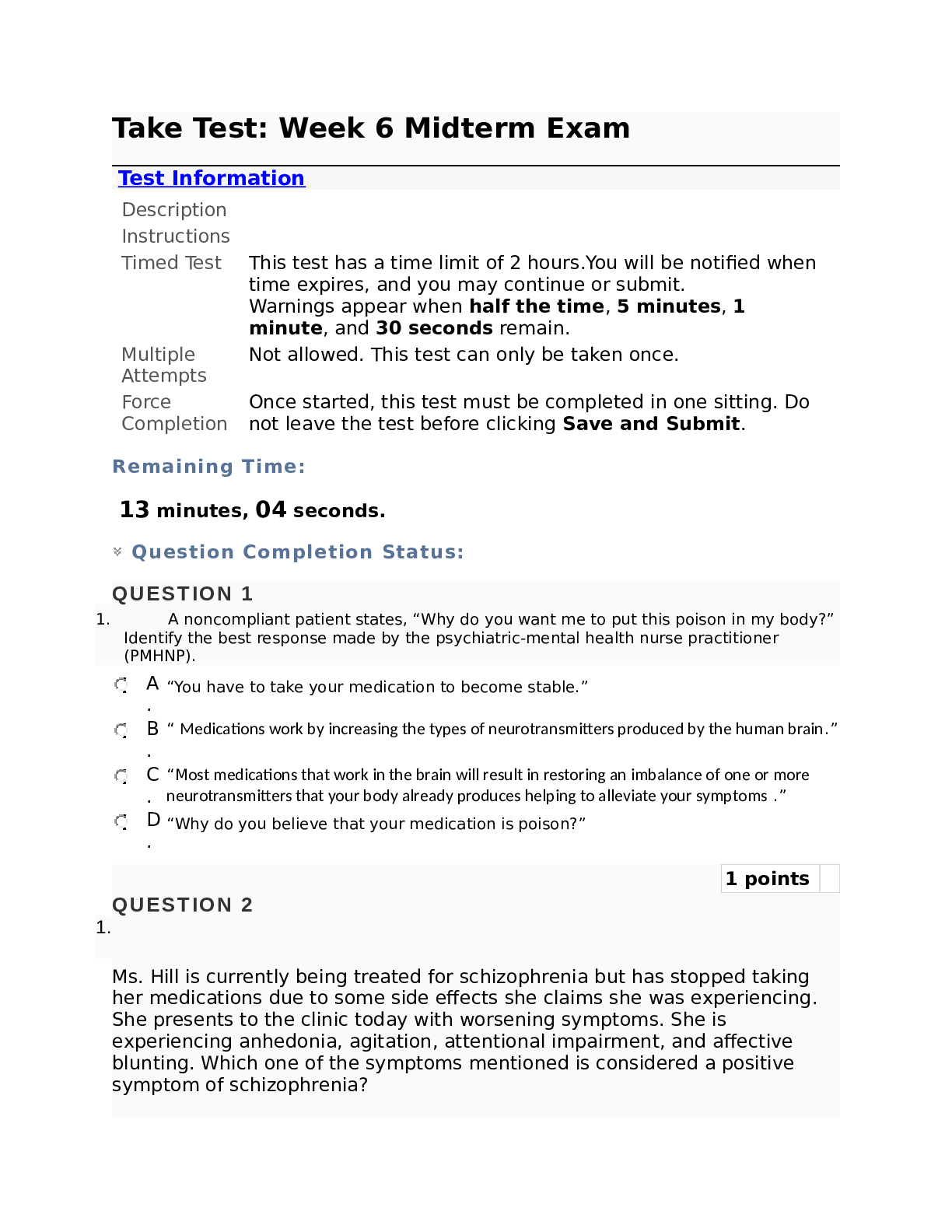
Buy this document to get the full access instantly
Instant Download Access after purchase
Add to cartInstant download
Reviews( 0 )
Document information
Connected school, study & course
About the document
Uploaded On
Jul 14, 2021
Number of pages
52
Written in
Additional information
This document has been written for:
Uploaded
Jul 14, 2021
Downloads
0
Views
41

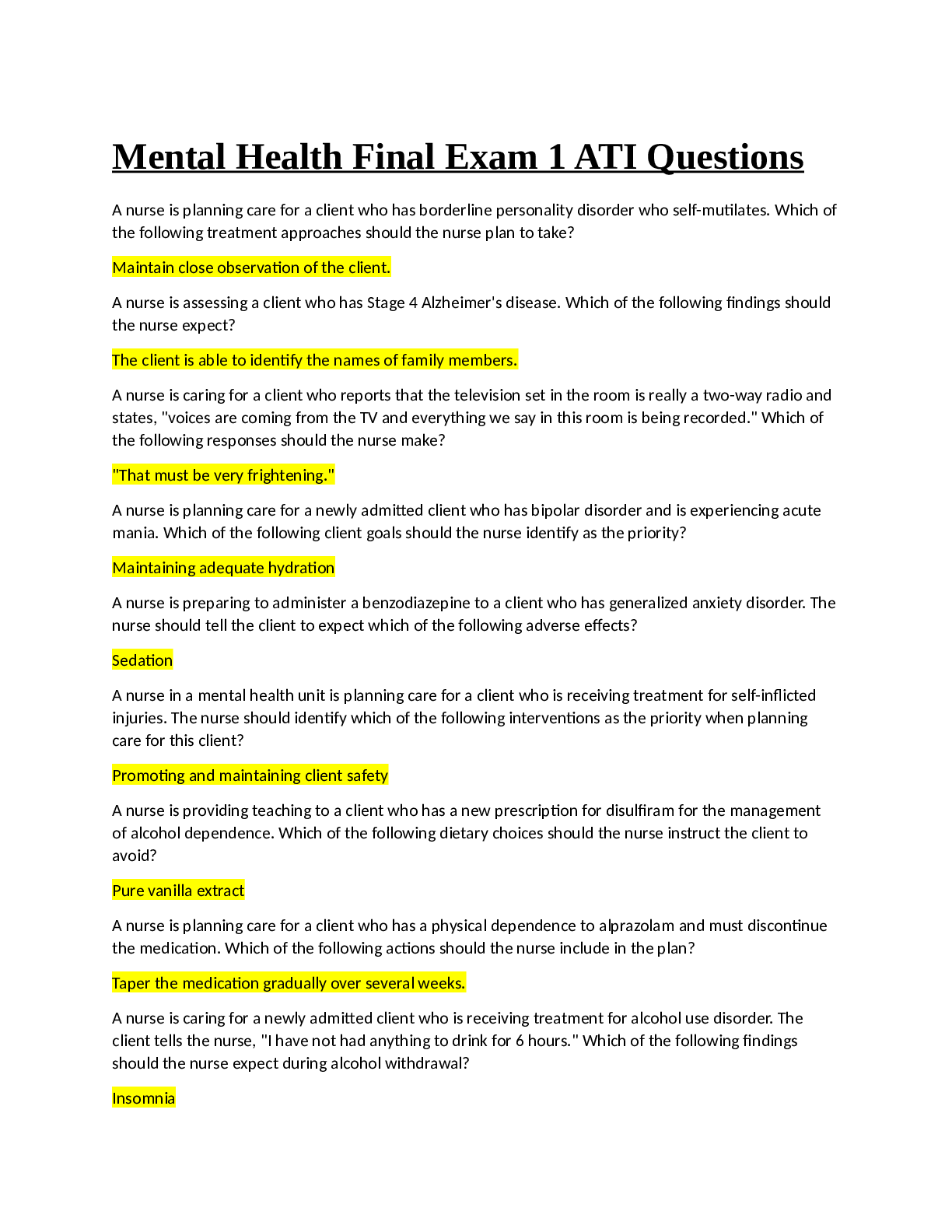
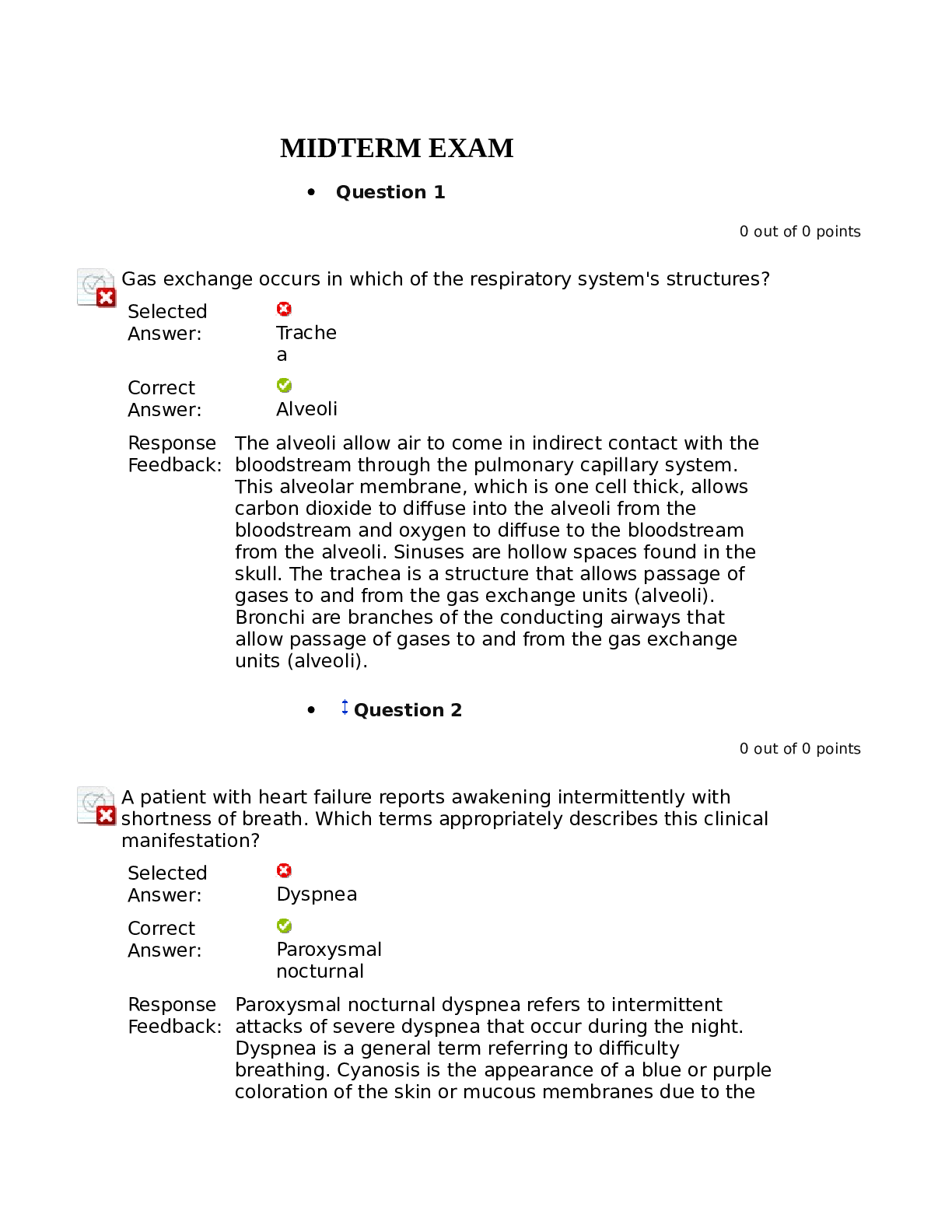
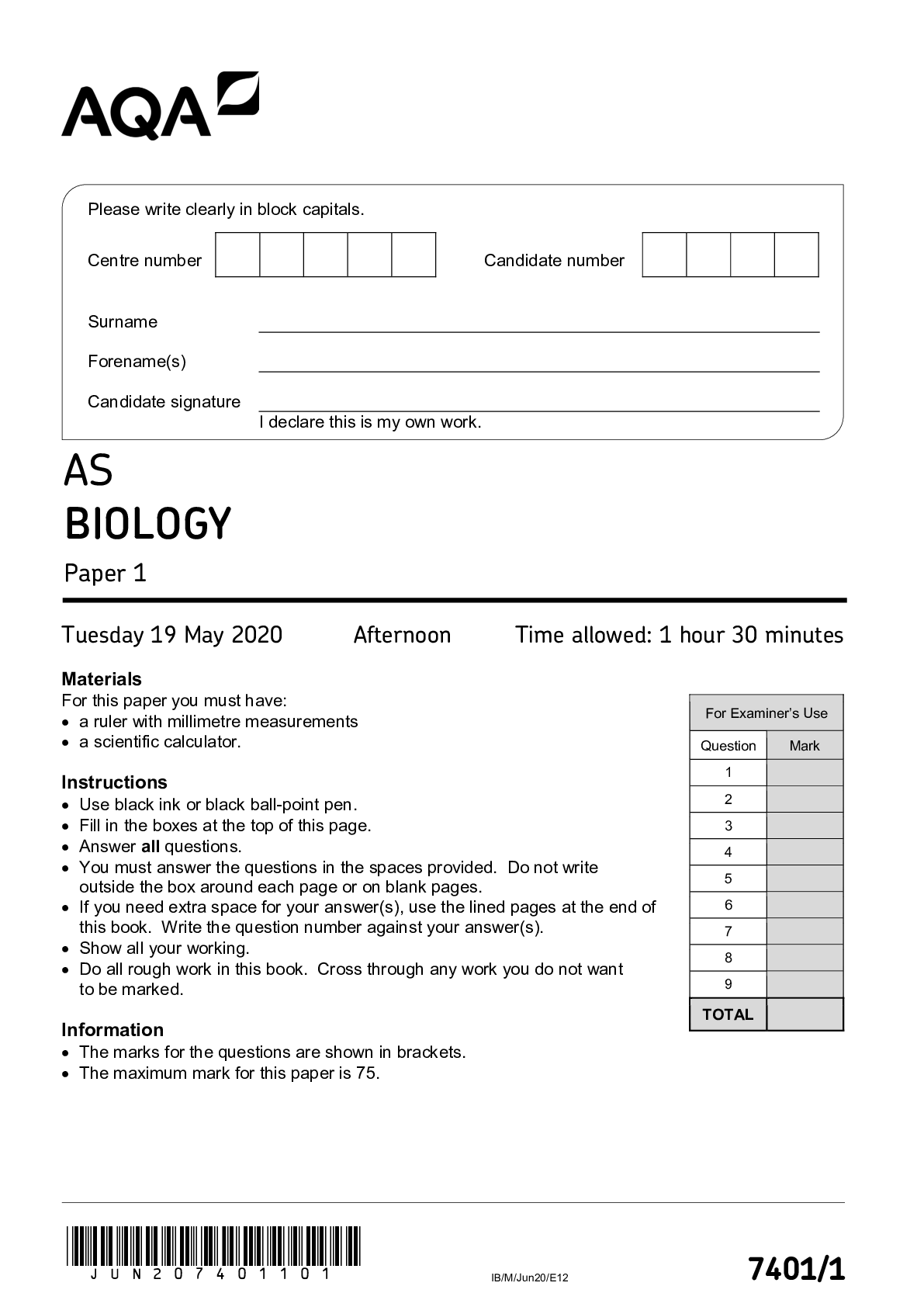





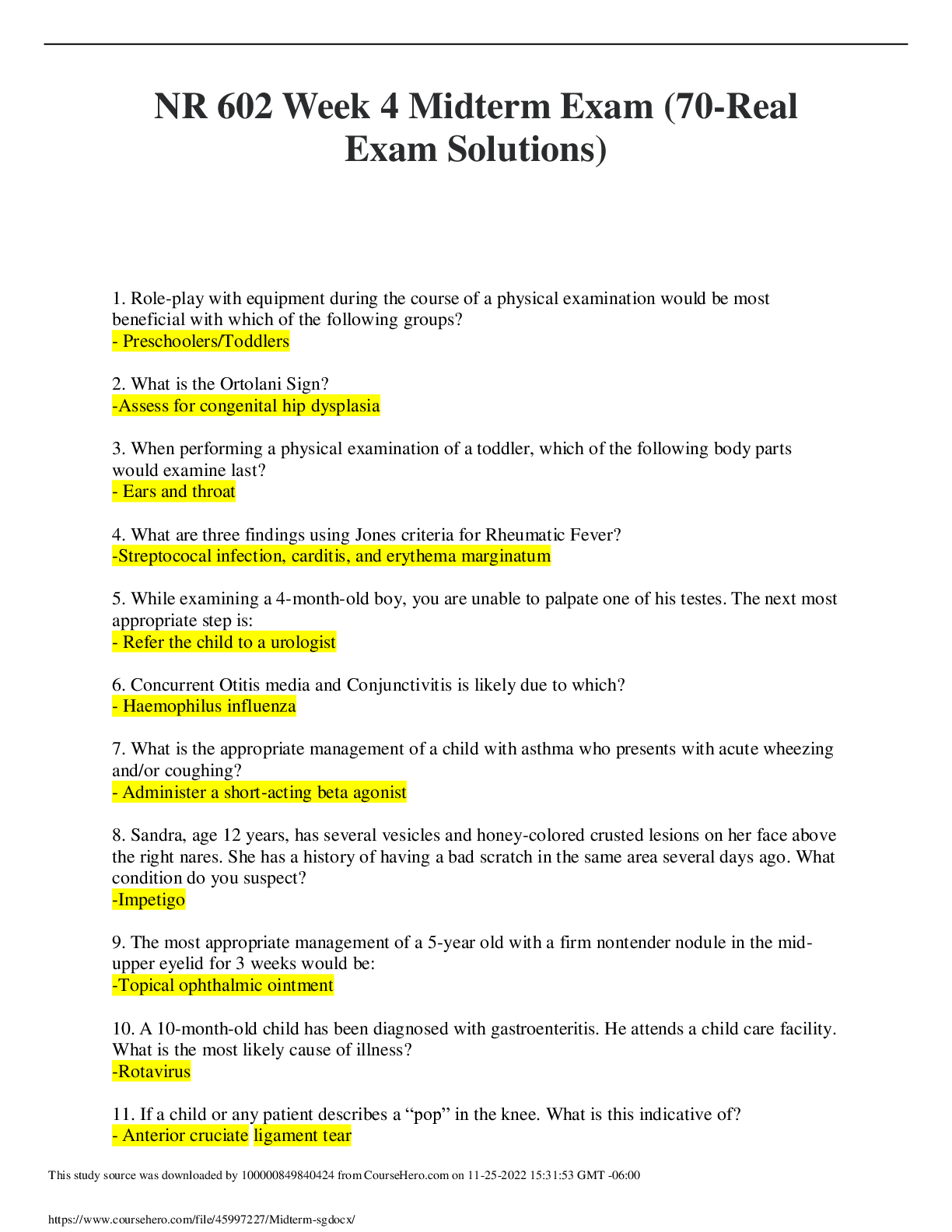
.png)
